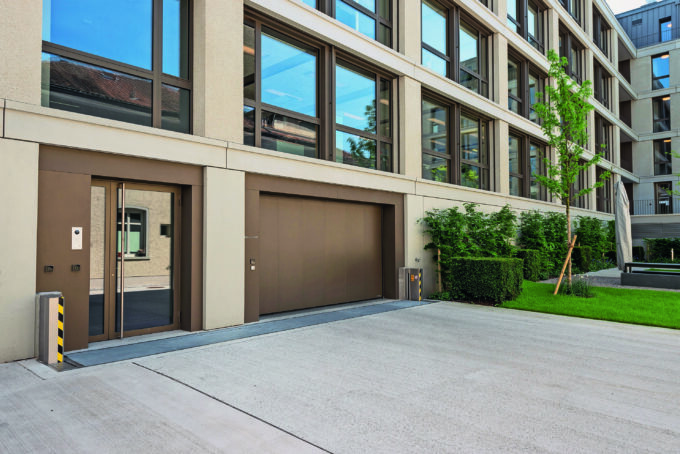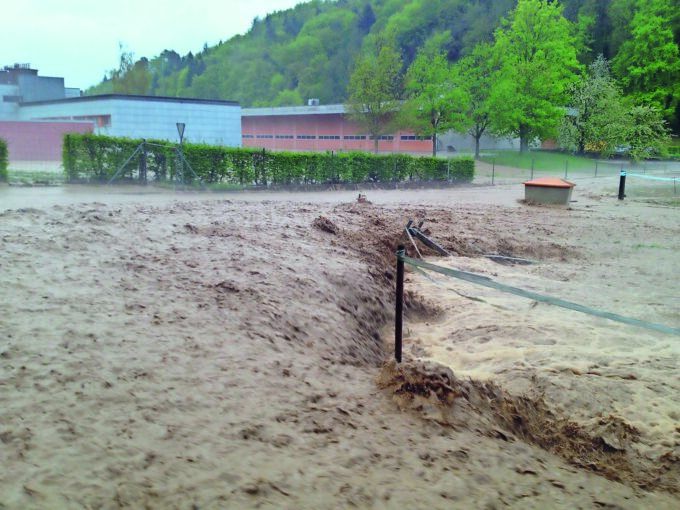Do companies need to become more "weatherproof"?
Climate change is also changing the hazard and risk situation for structural conditions. Comprehensive risk screening of company premises is becoming essential.

Climate change is progressing rapidly. We are already 2 degrees of warming behind us compared to the reference year 1864. If greenhouse gas releases increase unrestricted (RCP 8.5), an additional 3.3 degrees temperature increase over today is expected by mid-century. Even with comprehensive measures to reduce greenhouse gas emissions (RCP 2.6), warming of 2 degrees is assumed.
However, climate change will not only bring about an increase in temperature. The seasonal precipitation development will change significantly. The average precipitation total will decrease in summer, resulting in more dry summers. In winter, on the other hand, it will increase. Heavy precipitation will become more frequent and up to 30 % more intense.
The expected impacts for different emission or warming scenarios are available according to the Swiss climate scenarios CH2018.
Risk analysis
Natural hazards are already classified as one of the three biggest risks for business failures. The need for a systematic consideration of potential natural hazards and changed hazard bases due to climate change is therefore given.
The basis for a future-oriented risk analysis to reduce business failures as a result of a natural event is the currently valid and the expected hazard patterns. Whether your company is affected by natural hazards can be identified through a targeted risk screening in three phases.
- Impact Analysis
- Risk analysis
- Evaluation of measures
The result of the impact analysis shows whether the examined company site is located in the hazard perimeter, which parts of the company site are affected and by which natural hazards the site is affected. The risk analysis by means of an on-site inspection shows the local hazard of the objects. Weak points and intrusion points on buildings can thus be identified. In addition, a damage estimate can be made for property and personal risks in the event of an incident. The risks are identified, checked and evaluated according to defined criteria. In addition, unacceptable risks are prioritized. The evaluation of measures aims to identify cost-effective and effective measures. The three-phase risk screening thus enables efficient identification of risk hotspots.
Unrecognized hazards and unknown vulnerabilities are the basis for unconsciously assumed risks. Such risks must be avoided by periodically reviewing the hazard images to ensure that they are up to date. If there is no official basis for the hazards, local or selective hazard clarifications can close this gap in a targeted manner.
Particularly when evaluating new operating sites, care should be taken to ensure that appropriately detailed bases are available for all relevant hazard types. Otherwise, it is a case of flying blind with regard to the risks posed by natural hazards. Among other things, the maps of natural hazards serve as hazard bases: the nationwide hazard map of surface runoff as well as cantonal hazard and intensity maps for various processes. These maps can be found on the cantonal geoportals.
Identified unacceptable risks can be systematically included in the planning process in the context of new construction and renovation. Can the risk be avoided locally? Is resilient construction the solution? In EU standards (Eurocode 1), actions from earthquakes, wind and snow have been the standard for some time. Regulations for the effects of floods, surface runoff, hail, landslides and the like are missing. This gap could be closed in Switzerland in the meantime. It promotes natural hazard-compatible or resilient construction.

Flood
In the case of floods, a locally higher intensity is to be expected in the future due to heavier heavy precipitation. This precipitation in turn causes flooding as surface runoff, which must also be included in the hazard picture. A prime example was last summer 2021, when the federal government declared the highest warning level for the surface water flood situation in some places in Switzerland. Due to late, rapid snowmelt and heavy thunderstorms, various hydrological highs were exceeded since the beginning of the measurement period. Lakes such as Lake Neuchâtel, Lake Lucerne and Lake Thun overflowed their banks. Floods occurred in small and larger rivers. In some cases, the groundwater level rose so high that it flooded building basements. Protection against flooding due to heavy precipitation, streams, rivers, lakes, surface water and groundwater can be ensured by structural and organizational measures. The water can be diverted from the desired perimeter and thus the object can be shielded. By sealing the building envelope (hinged bulkheads, flood protection doors and windows), water can be prevented from entering the building from the outside. By building with an elevated layout, critical infrastructure can be protected up to a certain water level. In addition, wet precautions with an interior finish that is impervious to water can reduce the potential for damage from flooding.
Hail
In connection with more frequent strong thunderstorm cells, hail is increasingly to be expected. About one third of the damage to buildings caused by natural events is due to hail. Besides roofs, facades, windows and blinds are also exposed to hail. A hailstorm can penetrate the facade plaster and damage the underlying thermal insulation system. Plastic skylight domes can become brittle due to solar radiation. An easy target for hail. The previous record for building damage caused by hail in Switzerland was 260 million Swiss francs in 2009, and the projection of hail damage to buildings for 2021 is over 700 million Swiss francs. With regard to the impact of hail, the hail register (similar to the fire protection register, see www.hagelregister.ch) has provided an important basis for planning. It serves the building owner and the facade planner as a planning aid for hail-resistant materials and systems.
Drought
Climatic hazards such as drought, forest and field fires, and heat waves are generally expected to have entirely new dimensions of hazard. So far, such impacts have hardly been included in risk analyses for company locations in Central and Northern Europe, respectively the resulting risk was generally low to negligible. This can no longer be expected for the medium planning future. In particular, the supply of river water in the summer half-year for cooling purposes will hardly be available any more. Water-intensive production facilities will have to look for locations with drought-resistant water supplies.
Conclusion
An operational disruption caused by a natural hazard can last for months. The systematic analysis of current and intensified hazards at the operating site that are to be expected as a result of climate change is therefore an indispensable basis. The risk identification and assessment based on this analysis shows the need for action and is thus an efficient methodology for the targeted use of financial resources for protective measures. In this way, resilient buildings and effective protection concepts can be implemented on a risk basis.









